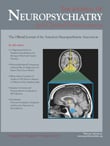Diagnostic Pitfalls in a Patient With Posttraumatic Exaggerated Startle Response and Mutistic Stupor
To the Editor: The differentiation of organic and psychogenic stupor is of major relevance in clinical practice. Mutistic stupor is a clinical manifestation of many psychiatric disorders in which the basal ganglia, frontal lobes, and limbic system are involved. 1 We report an unusual case of sporadic Creutzfeldt-Jakob disease with mutistic stupor, initially suspected as a posttraumatic dissociative reaction.
Case Report
Mrs. D, a 62-year-old Caucasian woman, presented to our hospital in December 2008 with mutistic stupor. Her daughter reported an acute onset of symptoms directly after a bombing attack very close to their house in Georgia. Since that point Mrs. D was reputedly numbed, showing avoidance behavior, hyperarousal, exaggerated startle, anxiety, disorientation, dissociation with memory loss, insomnia, and progressive mutism. One month earlier she was attacked by heavily armed criminals in her own apartment. Mrs. D had already been treated with sulpiride and risperidone without showing improvement but experienced extrapyramidal side effects (early dyskinesia, parkinsonism, and orofacial dystonic reactions). A subsequent vast exacerbation of the symptoms, with persisting mutism and akinesia, finally led to the admission in our clinic.
Our patient showed a broad spectrum of posttraumatic-typical symptoms following exposure to traumatic events. The history of traumatization, the initial nonpathological neurological status, preadmission outpatient MRI, blood testing and lumbar puncture, as well as the nonspecific alterations of the initial EEG, underlined the hypothesis of a posttraumatic reaction. Only a subsequent conduction of all diagnostic measures and the later-on emerged myoclonias provided enough findings in order to revise this hypothesis: The control MRI displayed bilateral hyperintensities in the basal ganglia, the control EEG showed bi- and triphasic synchronized sharp wave complexes, and the liquor serology elevated 14-3-3 proteins, as typically reported in sporadic Creutzfeldt-Jakob disease patients. 2 , 3
Discussion
Sporadic Creutzfeldt-Jakob disease is a rare neurodegenerative disease with rapidly progressive course and extensively observed psychiatric symptoms, which appear mostly within 100 days of onset, often including exaggerated startle. 2 , 4 Approximately 10% of these patients are first admitted to psychiatric clinics with erroneous clinical diagnoses. 5 This case demonstrates that symptoms caused by the sporadic onset of Creutzfeldt-Jakob disease may mimic posttraumatic symptoms. Exaggerated startle response and stupor after severe traumatic experiences may sometimes have non-trauma-related etiopathogenesis and require a careful differential diagnostic procedure.
1. Altshuler LL, Cummings JL, Mills MJ: Mutism: review, differential diagnosis, and report of 22 cases. Am J Psychiatry 1986; 143:1409–1414Google Scholar
2. Zerr I, Poser S: Clinical diagnosis and differential diagnosis of CJD and VCJD: with special emphasis on laboratory tests. APMIS 2002; 110:88–98Google Scholar
3. Zerr I, Pocchiari M, Collins S, et al: Analysis of EEG and CSF 14-3-3 proteins as aids to the diagnosis of Creutzfeldt-Jakob disease. Neurology 2000; 55:811–815Google Scholar
4. Will RG, Matthews WB: A retrospective study of Creutzfeldt-Jakob disease in England and Wales 1970–79, I: clinical features. J Neurol Neurosurg Psychiatry 1984; 47:134–140Google Scholar
5. Wall CA, Rummans TA, Aksamit AJ, et al: Psychiatric manifestations of Creutzfeldt-Jakob disease: a 25-year analysis. J Neuropsychiatry Clin Neurosci 2005; 17:489–495Google Scholar



